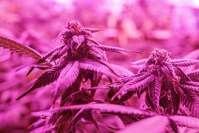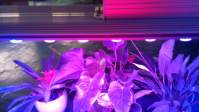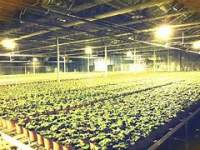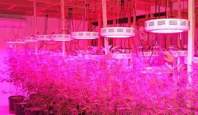The effect of LED plant light quality on the proliferation of tissue cultured seedlings
Studies have found that red light in monochromatic light can promote the proliferation of tissue cultured seedlings. Compared with the control fluorescent lamp, the number of single buds of the Phalaenopsis under the pure red LED plant lamp increased significantly, and the experiments of chrysanthemum and tobacco also reached similar conclusions. A single blue light is not conducive to the proliferation of tissue cultured seedlings. In the study of eustoma and sugarcane tissue culture seedlings, it was found that among all light quality treatments, the tissue culture seedlings under the monochromatic blue light treatment had the lowest growth coefficient. However, blue LED plant lights can effectively promote the formation of Phalaenopsis protocorm.
Experiments have shown that, compared with monochromatic LEDs, different combinations of LEDs are more conducive to the proliferation of tissue culture seedlings. The combination of red and blue LED plant light can promote the proliferation of sugarcane adventitious buds better than monochromatic light, which is better than fluorescent light and plant growth light. The regeneration effect of the adventitious buds of Rhododendron alpina leaves under the combined treatment of red and blue light is significantly better than that of 100% red and blue light. However, different plants or different varieties of the same species have different requirements for the light quality ratio at the stage of tissue culture proliferation. Rhododendron alpine leaves the best regeneration effect of adventitious buds under the treatment of red and blue light (3:1).
The effect of LED plant light quality on the growth of tissue cultured seedlings
Studies have shown that the effect of LED monochromatic light on the growth of tissue cultured seedlings is lower than that of different LED combined light, while red and blue LED combined light can enhance plant photosynthesis and promote plant growth and development. The growth of white palm tissue culture seedlings treated with a single red or blue LED is poor, and a certain proportion of red and blue LED compound light is beneficial to promote plant growth. The net photosynthetic rate of chrysanthemum tissue culture seedling leaves under the combination of red and blue light was significantly higher than that of monochromatic red and blue light, and the fresh weight and dry weight of the plant reached the maximum. The fresh and dry weight of strawberry sugar-free tissue culture seedlings is the smallest under blue light.
The optimal ratio of red and blue LED plant lights grown in tissue culture seedlings is inconsistent with the research conclusions of different plants. Japanese double butterfly and strawberry tissue cultured seedlings grow best under 70% red light + 30% blue light. However, the growth index of Anthurium andraeanum tissue culture seedlings under the treatment of 50% red light + 50% blue light was significantly higher than that of the control. Red light (R) treatment of white and tissue culture seedlings grow, blue light (B) treatment of white and tissue culture seedlings are low, compound light is conducive to the growth and morphology of white and white; 1RB light source treatment of white and tissue culture seedlings have significant soluble sugar content Higher than other treatments; red light and blue light (1:
In tissue culture production applications, adjusting the optimal red and blue ratio is the key to producing high-quality tissue culture seedlings.
The effect of LED plant light quality on the rooting and strong seedlings of tissue cultured seedlings
The effect of light quality on the induction and growth of isolated plant roots varies with the wavelength, and the effect of light quality depends on the plant genotype and rooting material concentration. Red light promotes the formation of adventitious roots of anthurium, phalaenopsis, imperial flower and ground cover chrysanthemum tissue culture seedlings. It is characterized by fast and dense rooting, and blue light has a significant inhibitory effect. Papaya tissue-cultured seedlings have the shortest root length under blue light; red and blue mixed light can promote the growth of sweet potato tissue-cultured seedlings to a certain extent. However, the root morphology of the tissue cultured seedlings under monochromatic red light is abnormal, and the survival rate of transplantation is low. Blue light helps to improve the vigor of the root system in the later stage, promote the accumulation of dry matter, reduce the water content, and prevent the vitrification of plants. Monochromatic red light irradiated the root system of chrysanthemum with low vigor, and the survival rate of transplanting was only 75%, while the transplanted tissue cultured seedlings survived under the combination of red and blue light. The root length and root vigor of Phalaenopsis treated with LED plant light combined with far red light were significantly increased compared with the control. Oncidium tissue culture seedlings have the longest root length under the combination of red and blue light, and the shortest root length under fluorescent light. Monochromatic red light irradiated the root system of chrysanthemum with low vigor, and the survival rate of transplanting was only 75%, while the transplanted tissue cultured seedlings survived under the combination of red and blue light. The root length and root vigor of Phalaenopsis treated with LED plant light and far red light were significantly increased compared with the control. Oncidium tissue culture seedlings have the longest root length under the combination of red and blue light, and the shortest root length under fluorescent light. Monochromatic red light irradiated the root system of chrysanthemum with low vigor, and the survival rate of transplanting was only 75%, while the transplanted tissue cultured seedlings survived under the combination of red and blue light. The root length and root vigor of Phalaenopsis treated with LED plant light and far red light were significantly increased compared with the control. Oncidium tissue culture seedlings have the longest root length under the combination of red and blue light, and the shortest root length under fluorescent light. The root length and root vigor of Phalaenopsis treated with LED plant light and far red light were significantly increased compared with the control. Oncidium tissue culture seedlings have the longest root length under the combination of red and blue light, and the shortest root length under fluorescent light. The root length and root vigor of Phalaenopsis treated with LED plant light and far red light were significantly increased compared with the control. Oncidium tissue culture seedlings have the longest root length under the combination of red and blue light, and the shortest root length under fluorescent light.
The LED plant lights used in the tissue culture stage will affect the growth and survival of the tissue culture seedlings after being transplanted outdoors. The indoor tissue culture stage uses a combination of red and blue LED light sources, which can increase the survival rate of strawberry, white brown, and chrysanthemum tissue culture seedlings, and promote the growth of seedlings after transplantation. Therefore, for plant tissue culture seedlings that are difficult to root, the rooting rate and root number can be increased through the pretreatment of red light in the early stage, and then adjusted to a certain proportion of red light, blue light and high beam. Cultivation uses red light to promote the growth and development of root system, improve root system vigor, and improve the adaptability of tissue culture seedling transplanting.
The light quality ratio of LED plant lights is different for different plants. The ratio of some plants is listed below:
(1) Lettuce: The light sources of red and blue light 6:1 and 7:1 respectively for planting and seedling cultivation are the most suitable for its growth.
(2) Leek: The ratio of plant height, stem thickness, leaf width and other mass ratios of leeks under the red/blue 7:1 treatment was significantly higher than other treatments.
(3) Cucumber: 7:2 is the best ratio of red and blue light for the growth of cucumber seedlings. And the growth period 7:1 is the best ratio of red and blue light.
(4) Strawberry, tomato: red and blue light 9:1 is good for full fruit and rich nutrition.
(5) Holly: Red and blue light are arranged according to the ratio of 8:1. Holly grows best, is strong and has a very developed root system.
(6) White radish: the most suitable light quality for growth: the ratio of red and blue is 8:1.
(7) Sprouts: The effect is the most obvious with the ratio of red, green and blue light of 6:2:1.
(8) Green vegetables and water spinach: 7:1 is the best ratio of red and blue light for the growth of green vegetables and water spinach leaves.
(9) Calla lily: For growth conditions, the ratio of 6:2 between red and blue light is the best.
(10) Lettuce: The ratio of red and blue light is 9:1, which is beneficial to the growth of lettuce.
(11) Anthurium andraeanum scorching sun: Comprehensive analysis, 7:3 red and blue light treatment is better, which is conducive to morphology, root growth and dry matter accumulation.
(12) Dendrobium officinale: Red and blue light 7:3, the proliferation effect is the best; at 6:4, it is more conducive to photosynthesis and material accumulation of seedlings.
The effect of LED plant light quality on plant photosynthetic characteristics, LED plant growth light has a regulatory effect on chlorophyll synthesis, leaves under red light have a higher chlorophyll content and a lower ratio of chlorophyll a to chlorophyll b. The values of chlorophyll a and chlorophyll b are extremely high under blue light, so more blue light is used to supplement light for light-loving plants. On the contrary, red light has a more obvious effect on supplementing light-loving plants.






